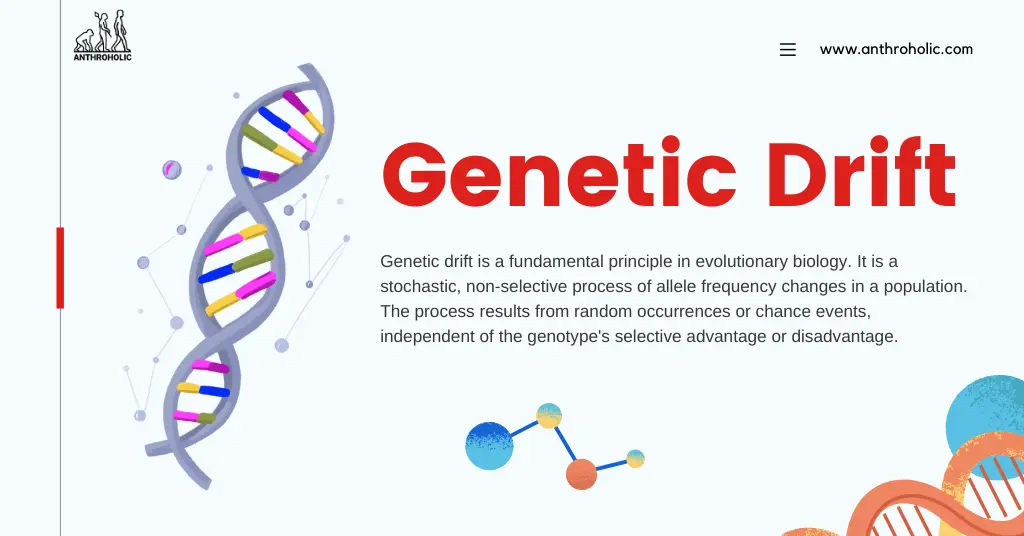AI Answer Evaluation Platform Live Now. Try Free Answer Evaluation Now
Genetic Drift
Genetic drift is a fundamental principle in evolutionary biology. It is a stochastic, non-selective process of allele frequency changes in a population. The process results from random occurrences or chance events, independent of the genotype’s selective advantage or disadvantage. Understanding genetic drift is essential to appreciate the full complexity of evolution and its influence on genetic diversity [1].

The Mechanism of Genetic Drift
Basics
In essence, genetic drift is a process of random sampling. Every generation, alleles are sampled from the existing gene pool to create the next generation. Due to random chance, some alleles get over or underrepresented, leading to changes in their frequency in the population [2].
Effects on Small Populations
Genetic drift has the most substantial effect on small populations. Small populations are more susceptible to the whims of chance, making it more likely that allele frequencies will deviate from generation to generation. This randomness could potentially lead to the disappearance of some alleles, thereby decreasing genetic diversity.
Bottleneck Effect and Founder Effect
Two special cases of genetic drift often observed are the bottleneck effect and the founder effect:
- Bottleneck Effect: Occurs when a population size significantly decreases due to a catastrophic event or environmental change, leaving a small, random assortment of individuals. The event can lead to genetic drift, where the remaining population has reduced genetic diversity [3].
- Founder Effect: Occurs when a new population is established by a few individuals. The new population’s gene pool isn’t representative of the source population, leading to genetic drift [4].
The Implications of Genetic Drift
Genetic Diversity
Genetic drift can significantly reduce genetic diversity, especially in small populations. This is because random fluctuations can inadvertently lead to the loss of certain alleles over time.
| Population Size | Genetic Diversity |
|---|---|
| Small | Lower |
| Large | Higher |
Speciation
Genetic drift is also an important factor in speciation – the process by which new species arise. When a small population is isolated from its parent population (for instance, by geographic barriers), genetic drift can result in significant genetic differences over time, leading to the emergence of a new species [5].
Genetic Drift vs. Natural Selection
While both genetic drift and natural selection lead to evolutionary changes, they operate differently:
- Genetic drift involves random changes in allele frequencies, regardless of their impact on fitness.
- Natural Selection involves changes in allele frequencies based on the advantage or disadvantage they confer on an organism’s ability to survive and reproduce.
Mitigating the Effects of Genetic Drift
Understanding the principles of genetic drift has allowed us to develop strategies to preserve genetic diversity, especially in endangered species. Conservation efforts often focus on maintaining large population sizes to reduce the impact of genetic drift and sustain the genetic diversity necessary for species’ long-term survival [6].
Interactions of Genetic Drift with Other Evolutionary Forces
While genetic drift is powerful in its own right, its effects are often influenced by interaction with other evolutionary forces, notably natural selection, gene flow, and mutation.
Genetic Drift and Natural Selection
As mentioned previously, genetic drift and natural selection are different but intertwined mechanisms that can alter the genetic makeup of a population. While natural selection is a deterministic process favouring alleles that increase an individual’s survival and reproductive success, genetic drift is entirely stochastic, with allele frequencies changing purely by chance. The interplay of these two forces can lead to a complex evolutionary landscape.
Genetic Drift and Gene Flow
Gene flow is the exchange of genes between populations. When individuals from different populations mate, they mix their genetic material, introducing new alleles into each other’s populations. This exchange can counteract the effects of genetic drift, maintaining or increasing genetic diversity. However, if gene flow is restricted (for example, by geographical barriers), genetic drift can act more powerfully, potentially leading to speciation [7].
Genetic Drift and Mutation
Mutation, the random alteration of genetic material, introduces new genetic variants into a population. While genetic drift can remove genetic variation by chance, mutation can restore it. This interplay can maintain a population’s genetic diversity over time [8].
Genetic Drift: A Key Component of Evolutionary Theory
The concept of genetic drift is vital for our understanding of evolution. It shows us that not all evolutionary change is adaptive. It highlights the role of chance and uncertainty in evolution, providing a counterpoint to the deterministic view offered by natural selection. Additionally, it underscores the importance of population size in determining the fate of genetic variants.
The table below summarizes the effects of genetic drift in conjunction with other evolutionary forces:
| Mechanism | Effects |
|---|---|
| Genetic Drift and Natural Selection | Complex, unpredictable changes in allele frequencies |
| Genetic Drift and Gene Flow | Maintenance or increase of genetic diversity |
| Genetic Drift and Mutation | Restoration of genetic variation |
Conclusion
Genetic drift is a central tenet of evolutionary biology, playing a critical role in shaping the genetic makeup of populations and potentially leading to new species’ emergence. It operates randomly and independently of natural selection, underscoring the unpredictability and complexity of evolutionary processes. Understanding genetic drift not only enriches our knowledge of evolution but also helps guide strategies for conserving biodiversity.
References
[1] Gillespie, J. H. (2004). Population Genetics: A Concise Guide. Johns Hopkins University Press.
[2] Hartl, D. L., & Clark, A. G. (2007). Principles of population genetics. Sinauer associates.
[3] Nei, M., Maruyama, T., & Chakraborty, R. (1975). The bottleneck effect and genetic variability in populations. Evolution, 1-10.
[4] Mayr, E. (1942). Systematics and the Origin of Species, from the Viewpoint of a Zoologist. Harvard University Press. https://doi.org/10.1073/pnas.0501939102
[5] Futuyma, D. J. (2013). Evolution. Sinauer Associates.
[6] Frankham, R., Ballou, J. D., & Briscoe, D. A. (2002). Introduction to Conservation Genetics. Cambridge University Press.
[7] Slatkin, M. (1987). Gene flow and the geographic structure of natural populations. Science, 236(4803), 787-792.
[8] Charlesworth, B., & Charlesworth, D. (2010). Elements of Evolutionary Genetics. Roberts and Company Publishers.




